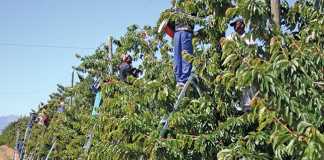
Blueberry production was seen as a good investment only a few years ago, but rising costs and price stagnation are now putting margins under severe pressure.
According to the Global State of the Blueberry Industry Report, based on interviews with industry participants across the world, overall input costs increased by 20% to 30%, while non-harvest costs increased by 50% to 100%.
Logistical challenges and higher transport costs seemed to have been less of a problem than last year. South Africa, however, was severely affected by port strikes, which led to a two-week shutdown and a 21% loss of fresh sales due to the perishable nature of the berries.
Herman van Dyk, chairperson of Berries ZA, told Farmer’s Weekly that South African farmers also had to deal with load-shedding on top of the rising input costs and logistical challenges.
Simultaneously, consumer spending was under pressure, resulting in average sales prices often declining year-on-year during peak periods. Opportunities to offset lower peak season pricing with higher return in fringe windows of scarcity had also diminished, despite growing demand.
According to the report, blueberry prices had a steady upward trend peaking at USD6,37/kg (about R120/kg) in 2018, then moving downwards to an average of US$5,82/kg (R110/kg).
The area under production, over this time, increased threefold, while total production quadrupled thanks to the emergence of varieties that could be grown in climates where not previously possible.
The area under production in South Africa, specifically, increased from 2 661ha in 2019 to 3 800ha in 2022.
To overcome the cost squeeze, a lot of emphasis is being placed on ways to increase productivity and production efficiencies.
“Growers are continuing to push the limits of yield in the way they structure their farms, how they prune or plant for certain harvesting windows, how they space out picking to ensure they have enough workers, and how they irrigate to optimise water usage,” according to the report.
As part of this, many producers are also converting old with new, improved varieties. Van Dyk said that farmers in South Africa were also trying to replace old with new varieties, but it was difficult financially to do so as many have been struggling to make ends meet for the past couple of seasons. He added that there had not been any noteworthy plantings over the past year.
According to the report, there is a trend towards consolidation to achieve greater economies of scale, with large companies starting to replace family-owned businesses. Van Dyk expected the number of South African growers to also become smaller.
Another big trend is that the benchmarks on quality have increased. The growth in new varieties have led to the availability of products with different eating experiences and sizes. Some varieties are achieving premiums because of this difference and are in higher demand.
The price difference between organic and conventionally grown blueberries is also declining.
In many countries, the cost of labour and availability of workers have become a problem. To overcome this, growers are sourcing workers from other countries, while those whose varieties allow it are switching to machine harvesters. Machine harvesting is also sparking new growing trends, as the berries need to be trellised and pruned in a way that allows the plants to stay upright.
Labour availability is not yet as big an issue in South Africa as in developed countries. Simon Back from Backsberg, between Paarl and Franschhoek, however, pointed out that they had developed and are using a semi-autonomous robot, called ARCi, in their blueberry orchards to improve worker efficiencies.
“The robot is more of a carrying device than a harvester and is still in the developmental phase. I don’t know of any other South Africans using such a device yet,” he said.
He added that artificial intelligence, robotics and other digital solutions would become increasingly important for producers in future to help improve their efficiencies and in effect maintain their competitive edge.












